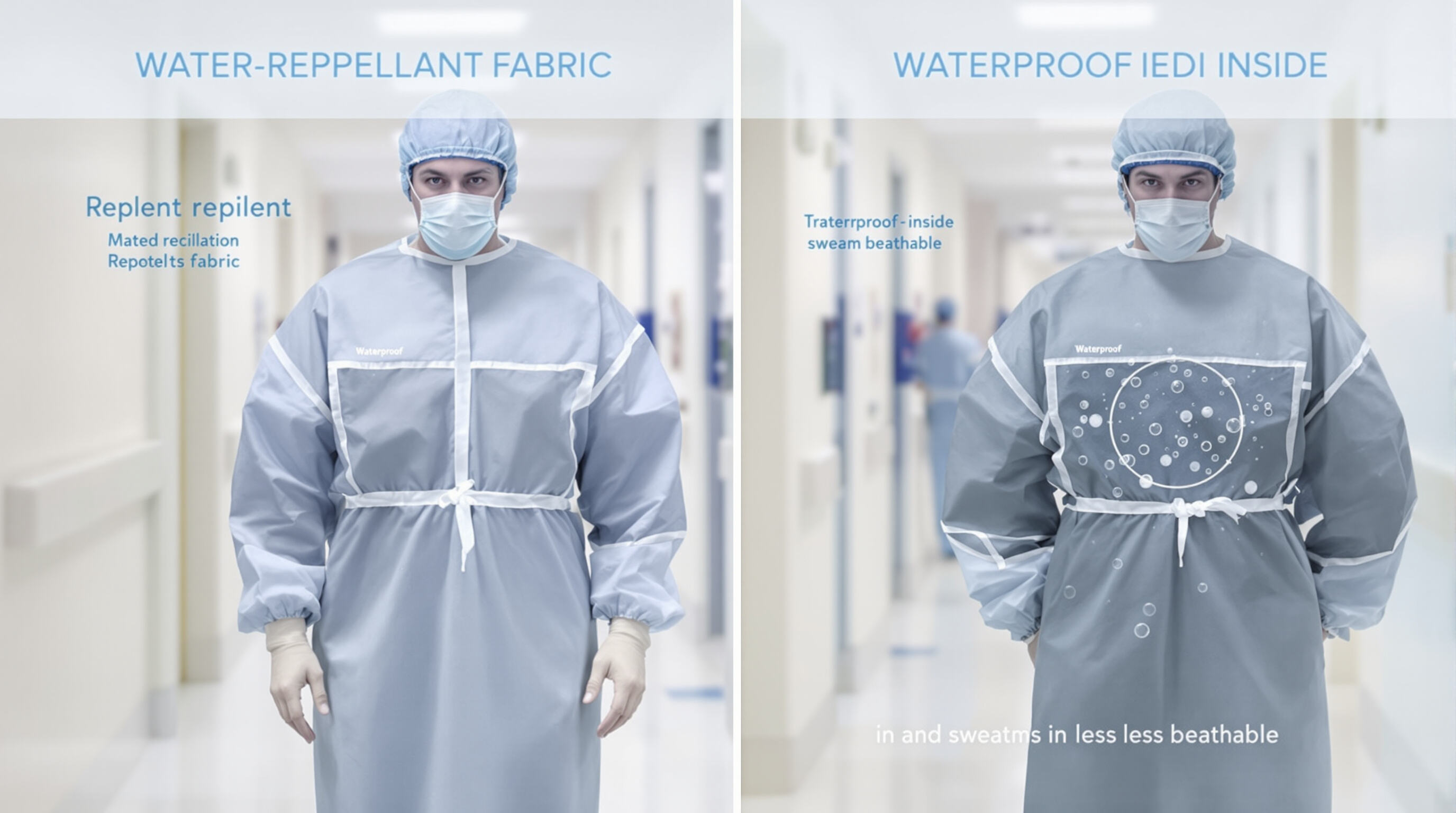The Science Behind Water-Repellent Fabrics in Medical Gowns
Isolation gowns that repel water rely on clever fabric technology to stop liquids from getting through while still letting air pass. Most medical grade materials are made from stuff like polyamide or polyester which get special treatments called DWR coatings. These coatings can be things like fluoropolymers or silicone that basically lower how much the fabric wants to absorb liquid. When worn by healthcare workers, the fabric actually makes water form into little beads that just slide right off rather than being soaked up. Tests done recently show these gowns keep working pretty well too, maintaining around 95 to almost 100 percent water resistance even when they're bent and stretched repeatedly throughout normal hospital work.
Hydrophobic Coatings and Their Role in Barrier Enhancement
When fabrics get treated with hydrophobic stuff, they become much better at keeping things out because the surface gets changed at a really tiny level. Think about those little ridges or holes on a nanoscale in these coatings - they work kind of like what happens on lotus leaves where water just rolls off. Tests were done where they sprayed stuff similar to what might happen during medical emergencies, like when blood sprays around at 2 psi pressure. The results showed that clothes treated with multiple layers of this hydrophobic coating stopped fluids from getting through about 83% better than regular untreated fabric. But there's one big catch though. If the seams aren't properly sealed, then all that good work goes down the drain. Some studies found that unsealed stitching areas could actually let in 40% more liquid, which really highlights why every part of the garment needs to be protected properly.
Water Repellency vs. Waterproofing: Key Differences for Isolation Gown Performance

Waterproof materials create barriers that stop all liquid from getting through, but they don't handle sweat well at all. Water repellent fabrics strike a better balance between keeping fluids out while still letting air circulate, which prevents overheating when wearing protective gear for long periods. For instance, waterproof materials trap around three times more moisture vapor inside the garment. This can cause body temperature to rise about 1.5 degrees Celsius each hour. Water repellent materials, on the other hand, allow air circulation, helping maintain safe body temperatures while offering protection against splashes and droplets. They also meet the standard requirements set forth in ASTM F3352 tests where garments must withstand at least 10 milliliters of water exposure.
AAMI Levels & ASTM F3352 Standards: Ensuring Fluid Barrier Protection
Decoding AAMI PB70: Liquid Barrier Performance and Classification
According to the AAMI PB70 guidelines, the liquid barrier performance and classification range from Level 1 to Level 4. For example, situations with low fluid contact, such as routine exams or venipuncture, call for Level 1 and 2 gowns, while high-risk procedures require Level 4 protection. By adhering to this classification system, healthcare professionals can choose appropriate gowns that balance protection and resource use, reducing contamination and infection risks.
ASTM F3352: Seam Strength and Blood Penetration Standards
ASTM F3352 specifies test methods for seam strength, breathability, and synthetic blood penetration. As emphasized in the 2024 Fluid Protection Guidelines, this standard complements AAMI PB70 by addressing real-world durability, reducing strikethrough risks by 63%.
Impact of Different Gown Levels in Clinical Settings
Hospitals adopting this risk-based framework report 41% fewer contamination incidents in high-acuity units (CDC Case Study 2024). Level 3 gowns are suitable for moderate-risk tasks like emergency room triage, while Level 4 gowns are necessary for intensive care interventions or surgeries involving aerosol-generating tools as they resist over 50 cm H₂O pressure, maintaining nearly 99.9% microbial barrier efficacy after 30 minutes of continuous wear.
Material and Design Elements Enhancing Isolation Gown Protection

Fabric Composition: The Building Blocks of Resistance
The effectiveness of isolation gowns depends heavily on how their materials are put together to stop fluids from getting through. Thicker fabrics weighing around 2.5 to 3 ounces per square yard work effectively, blocking about 98% of microbes. Advanced material mixes, such as nanocomposites, have been shown to repel liquids 40% more efficiently than regular materials.
Evaluating Resistance to Fluid Strikethrough and Leakage Risks
Hydrostatic pressure testing simulates real-world fluid exposure. Higher-performing isolation gowns are designed to prevent fluid strikethrough by utilizing lamination and seam integrity to achieve high ASTM F3352 pass rates. This significantly reduces leakage risks compared to older materials, ensuring better infection control.
| Material Type | ASTM F3352 Pass Rate | Features |
|---|---|---|
| Laminated PP/PE | 98% | Seam integrity, abrasion resistance |
| Microporous Films | 94% | Hydrostatic pressure handling |
| Advanced Nanocomposites | 98% | Enhanced liquid repellency, lightness |
Case Study: Outbreak Containment Using High-Barrier Isolation Gowns
During a 2023 norovirus outbreak, hospitals using AAMI Level 3+ rated gowns saw a 72% reduction in healthcare worker (HCW) contamination rates compared to those using lower-rated gowns in high-risk environments. This highlights the importance of high-barrier gowns in reducing exposure to infectious agents.
Design Features and Doffing Procedures That Minimize Contamination Risks
The design of isolation gowns contributes to their overall effectiveness. Ergonomic features like thumb loops and tension-distributing shoulder seams improve mobility and reduce tearing risks. The durability is demonstrated by laser-sealed edges and wide overlap back closures, ensuring full coverage during intense activities. Proper doffing techniques, following guidelines such as the 6-step method, are crucial to minimize the risk of contamination during gown removal, reducing incidents of needlestick injuries and splash exposures. Using augmented reality modules for training can further reinforce these critical procedures.
FAQ
What is the difference between water-repellent and waterproof isolation gowns?
Water-repellent isolation gowns create a barrier that lets air circulate while keeping fluids out, preventing overheating during prolonged use. In contrast, waterproof materials block all liquids but can also trap moisture and raise body temperature.
Why are proper gown seams and designs important?
If the seams of an isolation gown aren't sealed correctly, fluids can penetrate through stitching areas. Proper seam sealing is crucial to maintain the gown's barrier effectiveness.
When should higher AAMI-rated isolation gowns be used?
Higher AAMI Level 4 isolation gowns are recommended for high-risk procedures, such as surgeries with aerosol-generating tools or when treating COVID-19 patients in ICUs, to prevent fluid and microbial contamination effectively.
What is the significance of ASTM F3352 standards?
ASTM F3352 sets test methods for factors like seam strength and fluid penetration, complementing AAMI PB70 standards. It ensures real-world durability and minimizes strikethrough risks, ensuring enhanced protective performance under clinical stress conditions.
Table of Contents
- The Science Behind Water-Repellent Fabrics in Medical Gowns
- Hydrophobic Coatings and Their Role in Barrier Enhancement
- Water Repellency vs. Waterproofing: Key Differences for Isolation Gown Performance
- AAMI Levels & ASTM F3352 Standards: Ensuring Fluid Barrier Protection
- Material and Design Elements Enhancing Isolation Gown Protection
- FAQ


